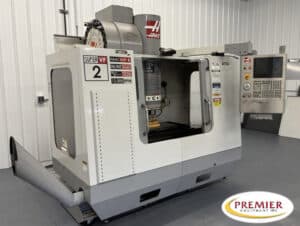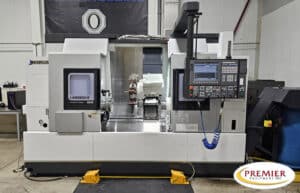Computer numerical control has been used to help machine parts with excellent precision, repeatability and tolerances for decades. Traditionally, CNC mills were designed in a vertical orientation with the tool meeting the workpiece from above. However, horizontal milling offers some substantial advantages over the vertical arrangement. With used CNC mills from Premier Equipment, you can get started with horizontal CNC for less.
-
Increased Productivity
The horizontal setup allows the CNC mill to move the substrate through the machining center more efficiently. This means that lighter cuts are possible rather than deep cuts in order to achieve the same result. Therefore, the machine can move faster and produce more work in less time without excess heat.
Furthermore, other advantages such as tool-switching and more complex multi-axis movement translate to better productivity. The topline benefit of horizontal CNC machining is increased productivity. For many organizations, this alone justifies the upgrade.
-
Larger and More Versatile Automatic Tool Changers
Automatic tool changing has helped to take CNC milling to new levels of functionality. Machines being able to change their tools themselves means that they are significantly more versatile. It also greatly improves productivity and automation.
With a horizontal layout, ATCs can be larger and more comprehensive. Many horizontal CNC mills also have expandable and/or changeable ATCs that can allow for even more flexibility.
-
Multi-Part Machining on the B-Axis
The B-axis describes rotation around the Y-axis. Horizontal CNC machines can do this more capably than their vertical counterparts. They are able to use this advantage to machine multiple parts simultaneously using a tombstone.
Again, this translates to greater productivity for horizontal milling. With the right setup, multiple parts can be machined on a tombstone by the CNC machine while team members prepare the next tombstone. This is a fast and efficient way to make multiple parts at once with high precision and tight tolerances.
-
Reduced Part Handling
Thanks to their greater flexibility and function, horizontal CNC machines typically can do more of the process themselves. Therefore, they require significantly less part handling. Teams can leave workpieces in place and simply let the machine handle the full process of machining. Some CNC machines have pallet changers that allow them to switch in and out workpieces.
The resulting improvement in efficiency is enormous. Between an automatic tool changer and an automatic pallet changer, a horizontal CNC machine can potentially more than double its uptime versus a traditional vertical CNC mill.
-
Improved Chip Evacuation
Finally, machining inherently creates a lot of chips from the workpiece. These need to be cleaned consistently from the mill to ensure that they do not get into the tools or remain too long on the workpiece. They can increase tool wear and reduce product quality. While nearly all CNC machines have chip cleaning and evacuation, often aided by the coolant, the orientation can have a big impact on the efficiency of these systems.
Typically, horizontal mills are able to evacuate chips more efficiently. This reduces the risk of damage to the tools or product. It also means that the machine does not require as frequent manual cleaning as traditional CNC machines, therefore increasing productivity.
Get Started With Horizontal Milling
There are a variety of other benefits associated with horizontal milling. Some of these are simply due to the fact that horizontal mills tend to be built with better feature sets than their more traditional, vertical counterparts. Nonetheless, there is a lot to love.
The main drawback of horizontal mills is that new ones tend to be more expensive than vertical CNC machines. Fortunately, you can enjoy the best of both worlds with Premier Equipment’s used CNC machines. Check out our catalog today.



